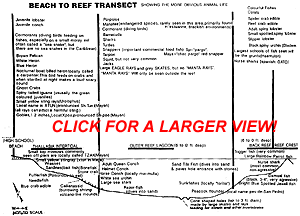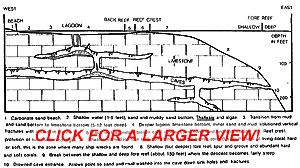
SNORKEL TRANSECT FROM BETWEEN THE SUN BREEZE HOTEL AND
RAMON'S REEF RESORT TO THE REEF, AND FORE REEF
The snorkel transect beyond the relative safety of the docks
is best done with at least two people and a floating diving flag
or better yet a boat. Fast moving skiffs pose a definite menace to
the snorkeler. The transect from the reef into the fore reef
requires calm weather, a boat and knowledgable guide to go through
the reef and approach it from the front side. If you wish to
examine anything deeper than the very shallow fore reef, scuba
gear and a dive master are required. Under no circumstances should
one attempt to swim out through one of the passes in the reef to
the fore reef without the presence of someone knowledgable about
the waters. Currents in these passes can exceed the ability of
even a powerful swimmer.
Click here for information showing the main points of the Outer Reef Lagoon, San Pedro and South, and the main cuts through the reef east of the island.
The beach sand (if there is no sea wall) consists of rounded
grains of calcite from the skeletons of all the organisms that
live between the beach and the reef. Geologists refer to it as
coralgal sand because most of the grains are coral and algal
fragments. If there is a sea wall, then the sand has been trucked
in from excavations in the interior of the island and consists of
varying mixtures of beach, shelf and lagoonal sands with all sorts
of skeletal fragments.

As you move out into the shallow water off store, there is
abundant sea grass, mainly Thalassia, and many different
types of algae trapping lime mud and sand. Many different organisms
inhabit this environment, including sea worms and other burrowers
such as the callianassid shrimp whose burrows are marked by mounds
of clean sand. Small fish, anemones and crabs live among the grass
and algae. Small foraminifera, bryozoa and worms encrust the
grass. Starfish and sea urchins also forage in this environment.
If stepped on barefoot, sea urchins can inflict painful wounds
with their sharp spines.
Further seaward in about 8 to 10 feet of water the mud and
sand gives way to Pleistocene limestone with a very thin sand cover
and soft corals (gorgonians, sea whips and sea fans) are able to
attach to the solid bottom and survive. In this more open
environment starfish, sea slugs and gastropods are more common. In
the vertically solutioned fractures or joints, fish and eels find
habitats, and on the rocky bottom the tile fish will build its
nest of stones. A lot of the lime mud and sand that is generated
and transported into this environment filters down through these
cracks into the cave system in the limestone. The environment
remains about the same in the deeper part of the lagoon which also
has a mostly rocky bottom.
In the back reef, carbonate sand again becomes thick and
broken coral fragments become more common. Soft corals live in
abundance and patches of Thalassia and algae again
appear
in larger numbers. in the immediate back reef there is a
profusion of broken and dead coral fragments and scattered
colonies of living coral. As this back reef material builds
up it can also be colonized by living coral and be
incorporated into the reef crest. The reef crest itself is
dominantly coral and binding or encrusting algae.
The immediate fore reef (from 2 to about 15 feet deep)
is sometimes referred to as the barren zone. This is the
part of the reef that takes the constant pounding of the sea
and consists mainly of large coral fragments. Small patches
of encrusting coral and algae survive to bind the debris into
a wave resistant mass. The reef slowly grows out over this
shallow environment. The immediate fore reef is the site of
numerous ship wrecks, as over the centuries many sailing
ships were driven onto the reef by storms. This process
continues today, but internal combustion engines and accurate
weather predictions make it much less common.
In the deeper part of the shallow forereef marine life
is again able to grow in profusion and the hard and soft
corals dominate although algae is also very common. This
portion of the reef is dominated by what is called spur and
groove topography. The spurs are ridges that rise above the
intervening grooves which are filled with white carbonate
sand and scattered larger coral fragments. The spurs
consist of hard corals partially colonized by soft corals and
algae. The origin of the spur and groove topography has been
hotly debated. Many feel that they are erosional ridges and
gullies formed when this environment was dry land during the
last ice age. Others argue that the movement of sand down
the gullies prevents the growth of corals and other reef
organisms which then preferentially build the spurs up above
the level of the grooves. Like so many other controversies,
the truth probably lies in the middle. The grooves may have
originated as erosional gullies and then been magnified and
preserved by the preferential coral buildups between them.
The grooves tend to get deeper with increased water depth and
at depths of 100 to 130 feet deep the grooves can be 30 or 40
feet deep.
As water depth increases, the amount of light that can
reach bottom diminishes. As this occurs, coral growth is
slowed and the massive and branching forms are replaced with
bladed and dish shaped types that have more surface area to
capture the available light. Below about 130 feet, the
forereef drops away steeply with much less active coral
growth as light penetration decreases and virtually ceases
around 300 feet.
Main Field Guide Page |
General |
Animals |
Plants |
Geology |
History |
Diving |
PLATE
1 |
2 |
3 |
4 |
5 |
6 |
7 |
8 |
9 |
10 |
11 |
12 |
13 |
14 |
15 |
16 |
This information courtesy of R. L. Wood, S. T. Reid, and A. M. Reid, and their
book
"The Field Guide to Ambergris Caye"
|